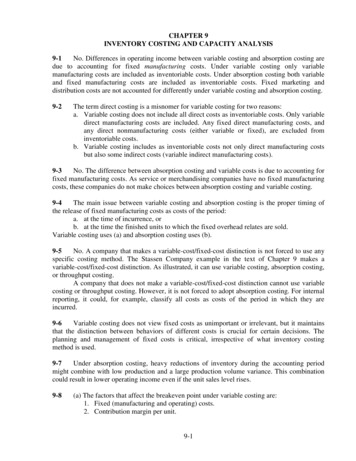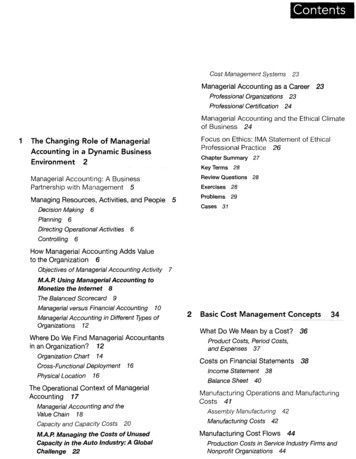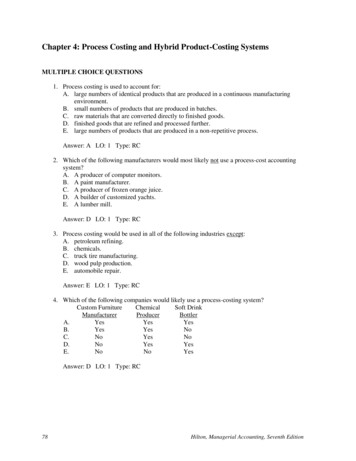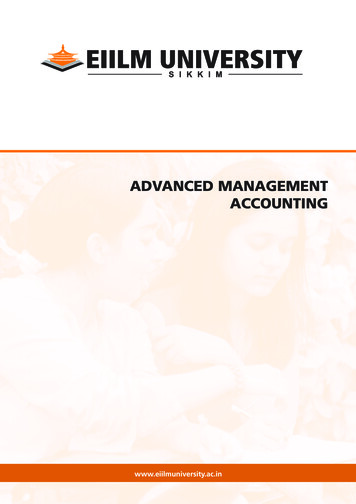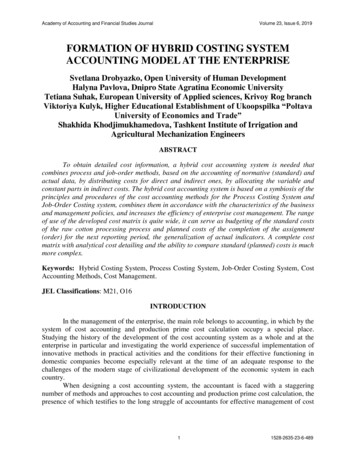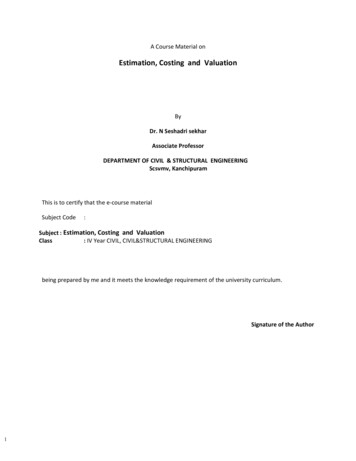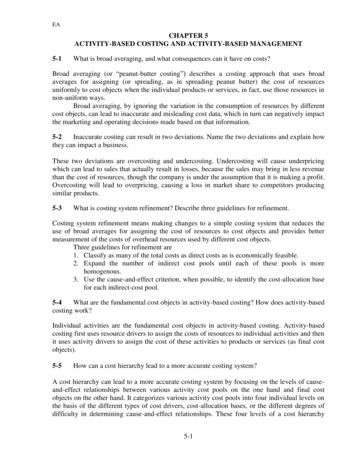
Transcription
EACHAPTER 5ACTIVITY-BASED COSTING AND ACTIVITY-BASED MANAGEMENT5-1What is broad averaging, and what consequences can it have on costs?Broad averaging (or ―peanut-butter costing‖) describes a costing approach that uses broadaverages for assigning (or spreading, as in spreading peanut butter) the cost of resourcesuniformly to cost objects when the individual products or services, in fact, use those resources innon-uniform ways.Broad averaging, by ignoring the variation in the consumption of resources by differentcost objects, can lead to inaccurate and misleading cost data, which in turn can negatively impactthe marketing and operating decisions made based on that information.5-2Inaccurate costing can result in two deviations. Name the two deviations and explain howthey can impact a business.These two deviations are overcosting and undercosting. Undercosting will cause underpricingwhich can lead to sales that actually result in losses, because the sales may bring in less revenuethan the cost of resources, though the company is under the assumption that it is making a profit.Overcosting will lead to overpricing, causing a loss in market share to competitors producingsimilar products.5-3What is costing system refinement? Describe three guidelines for refinement.Costing system refinement means making changes to a simple costing system that reduces theuse of broad averages for assigning the cost of resources to cost objects and provides bettermeasurement of the costs of overhead resources used by different cost objects.Three guidelines for refinement are1. Classify as many of the total costs as direct costs as is economically feasible.2. Expand the number of indirect cost pools until each of these pools is morehomogenous.3. Use the cause-and-effect criterion, when possible, to identify the cost-allocation basefor each indirect-cost pool.5-4What are the fundamental cost objects in activity-based costing? How does activity-basedcosting work?Individual activities are the fundamental cost objects in activity-based costing. Activity-basedcosting first uses resource drivers to assign the costs of resources to individual activities and thenit uses activity drivers to assign the cost of these activities to products or services (as final costobjects).5-5How can a cost hierarchy lead to a more accurate costing system?A cost hierarchy can lead to a more accurate costing system by focusing on the levels of causeand-effect relationships between various activity cost pools on the one hand and final costobjects on the other hand. It categorizes various activity cost pools into four individual levels onthe basis of the different types of cost drivers, cost-allocation bases, or the different degrees ofdifficulty in determining cause-and-effect relationships. These four levels of a cost hierarchy5-1
EA(from the highest to the lowest cause-and-effect relationship to cost objects) are: output unitlevel costs, batch-level costs, product-sustaining costs or service-sustaining costs, and facilitysustaining costs.5-6Which levels of cost hierarchy (under activity-based costing) are not used in simplecosting systems and why are they important?Out of four levels of hierarchy costs in activity-based costing, only ‗output unit-level costs‘ isused in simple costing systems. In other words, there are three additional levels of hierarchycosts in activity-based-costing systems which are not used in simple costing systems as follows:batch-level costs, product-sustaining costs or service-sustaining costs, and facility-sustainingcosts. These three additional levels of hierarchy costs are important because not all costallocation bases are unit level. Some are batch-level costs, some are product-sustaining costs andsome are facility-sustaining costs which have no direct link with the cost objects.5-7Differentiate between simple costing systems and ABC systems.The main difference between simple costing systems and ABC systems is due to having differentfocuses. Activities are the fundamental cost objects in ABC systems, while departments, centersor cost pools are the main fundamental cost objects in simple costing systems. Simple costingsystems have one or a few indirect cost pools, irrespective of the heterogeneity in the facilitywhile ABC systems have multiple indirect cost pools. Under ABS systems, the costs of activitiesare assigned to cost objects to compute their costs. Under simple costing systems, the costs ofdepartments, centers or cost pools are assigned to cost objects to compute their costs.5-8How can ABC help with cost reduction and process improvement decisions?ABC can help with cost reduction and process improvement decisions by identifying individualactivities and their relevant costs. This can help managers to eliminate non-added valueactivities, reduce costs and improve the overall process.5-9―The cost of cost objects under simple costing systems and under activity-based costingare never the same.‖ Do you agree? Explain.No. It depends on a number of factors such as the variety and number of activities, costallocation bases, and cost objects/products. For example: if a company produces one singleproduct then the product cost under both simple costing systems and activity-based-costing canbe the same. Or, when different products use resources from different activities in the sameproportions as with simple costing systems.5-10Describe the main barriers for adopting an ABC system.The main restrictions towards adopting an ABC system include the need to use more resources(e.g., experts and software packages) as well as the requirement for gathering additionaldata/information and performing more measurements to implement it. One of the maincomplications of ABC is that it requires managers to estimate costs of activity pools in order toidentify and measure cost drivers for specified cost pools to be used as cost-allocation bases. Itneeds many calculations to determine costs of cost objects and these measurements are5-2
EAexpensive. It needs to be updated regularly. As ABC systems get very detailed and more costpools are created, more allocations are needed to calculate activity costs for each cost pool, andthis could increases the chances of misidentifying the costs of different activity cost pools.Sometimes the data needed for the relevant allocation base is not readily available.5-11What are the main behavioral issues in implementing ABC systems?Gaining support of top management and creating a sense of urgency for the ABC effort. Creatinga guiding coalition of managers throughout the value chain for the ABC effort. Educating andtraining employees in ABC as a basis for employee empowerment. Seeking small short-runsuccesses as proof that the ABC implementation is yielding results. Recognizing that ABCinformation is not perfect because it balances the need for better information against the costs ofcreating a complex system that few managers and employees can understand.5-12Explain why ABC is equally important for both manufacturing and service companies.ABC systems can be used equally for product costing and service costing as well as for strategicdecisions in manufacturing and service companies. ABC systems are more suited to servicecompanies because a vast majority of their cost structure is composed of indirect costs.5-13 ―Activity-based costing is providing more accurate and detailed information and shouldreplace simple costing.‖ Do you agree? Explain.No. The additional costs and resources needed may not exceed the benefits gained by havingmore accurate and detailed information provided by the ABC system. Thus, cost benefit analysisis always needed to make sure that expected benefits exceed expected costs to replace simplecosting.5-14 What are the main factors determining the number of indirect-cost pools in a costingsystem, to increase the accuracy of product or service costs. Explain.The main factors for determining the number of indirect-cost pools are the homogeneity of costpools as well as the similarity in proportions at which different products/services use cost pools.The higher the homogeneity of cost pools, and the similarity of proportions of using differentactivities by products/services, the lower the number of required indirect-cost pools.5-15The total annual production cost of a manufacturing company that produces threedifferent USB devices is 10,000,000. The manager of the company states that the contributionmargins of all three products guarantee and justify their productions and, therefore, there is noneed to adopt ABC as the total manufacturing costs of the company would remain the same if thecompany did adopt ABC. How can you convince the manager to change his mind?It can be argued that the adoption of ABC may result in reduction of the total manufacturingcosts of the company. ABC can help with cost reduction and process improvement decisions byidentifying individual activities and their relevant costs. This can help managers to eliminatenon-added value activities, reduce costs and improve the overall process. So, it is not always truethat total manufacturing cost remains the same if a company decides to adopt ABC as5-3
EAeliminating non-added value activities can reduce the production costs. It can also be argued thatby adopting the ABC system, the manager will be in a better position to make improveddecisions in terms of pricing and product-mixed decisions. ABC could help to identify productsthat may be currently under-costed, and are being actually sold for losses, where the losses aremasked by sales of very profitable product lines.5-16 Conroe Company is reviewing the data provided by its management accounting system.Which of the following statements is/are correct?I. A cost driver is a causal factor that increases the total cost of a cost object.II. Cost drivers may be volume based or activity based.III. Cost drivers are normally the largest cost in the manufacturing process.1.2.3.4.I, II, and III are correct.I and II only are correct.I only is correct.II and III only are correct.SOLUTIONExplanation Choice "2" is correct.The question asks which of a series of statements is/are correct. "None of the above" is notavailable, so one of the statements at least is correct.Statement I says that a cost driver is a causal factor that increases the total cost of a cost object.Statement I is correct.Statement II says that cost drivers may be volume based or activity based. Cost drivers may bevolume‐based, activity‐based, or based on any number of other operational characteristics. So,that is two out of three. Statement II is correct.Statement III says that cost drivers are normally the largest cost in the manufacturing process.Cost drivers are what cause the costs, not the costs themselves. Statement III is incorrect5-17 Nobis Company uses an ABC system. Which of the following statements is/are correctwith respect to ABC?I. Departmental costing systems are a refinement of ABC systems.II. ABC systems are useful in manufacturing, but not in merchandising or service industries.III. ABC systems can eliminate cost distortions because ABC develops cost drivers that have acause-and-effect relationship with the activities performed.1.2.3.4.I, II, and III are correct.II and III only are correct.III only is correct.None of the listed choices is correct.5-4
EASOLUTIONExplanation Choice "3" is correct.The question asks which of a series of statements is/are correct with respect to ABC.Statement I says that departmental costing systems are a refinement of ABC systems. Actually,ABC systems are a refinement of departmental costing systems. Statement I is incorrect.Statement II says that ABC systems are useful in manufacturing, but not in merchandising orservice industries. ABC systems are useful in all three of these business sectors. Statement II isincorrect.Statement III says that ABC systems can eliminate cost distortions because ABC develops costdrivers that have a cause‐and‐effect relationship with the activities performed. Statement III iscorrect.5-18 Cost hierarchy. SharpPitch, Inc., manufactures karaoke machines for several wellknown companies. The machines differ significantly in their complexity and their manufacturingbatch sizes. The following costs were incurred in 2014:a. Indirect manufacturing labor costs such as supervision that supports direct manufacturinglabor, 950,000b. Procurement costs of placing purchase orders, receiving materials, and paying suppliersrelated to the number of purchase orders placed, 675,000c. Cost of indirect materials, 180,000d. Costs incurred to set up machines each time a different product needs to be manufactured, 450,000e. Designing processes, drawing process charts, and making engineering process changes forproducts, 315,000f. Machine-related overhead costs such as depreciation, maintenance, and productionengineering, 975,500 (These resources relate to the activity of running the machines.)g. Plant management, plant rent, and plant insurance, 578,000Required:1. Classify each of the preceding costs as output unit-level, batch-level, product-sustaining, orfacility-sustaining. Explain each answer.2. Consider two types of karaoke machines made by SharpPitch, Inc. One machine, designedfor professional use, is complex to make and is produced in many batches. The othermachine, designed for home use, is simple to make and is produced in few batches. Supposethat SharpPitch needs the same number of machine-hours to make each type of karaokemachine and that Forrester allocates all overhead costs using machine-hours as the onlyallocation base. How, if at all, would the machines be miscosted? Briefly explain why.3. How is the cost hierarchy helpful to SharpPitch in managing its business?SOLUTION(20 min.) Cost hierarchy.1.a. Indirect manufacturing labor costs of 950,000 support direct manufacturing laborand are output unit-level costs. Direct manufacturing labor generally increases withoutput units and so will the indirect costs to support it.b. Batch-level costs are costs of activities that are related to a group of units of a product5-5
EAc.d.e.f.g.rather than each individual unit of a product. Purchase order-related costs (includingcosts of receiving materials and paying suppliers) of 675,000 relate to a group ofunits of product and are batch-level costs.Cost of indirect materials of 180,000 generally changes with labor hours or machinehours which are unit-level costs. Therefore, indirect material costs are output unitlevel costs.Setup costs of 450,000 are batch-level costs because they relate to a group of unitsof product produced after the machines are set up.Costs of designing processes, drawing process charts, and making engineeringchanges for individual products, 315,000, are product sustaining because they relateto the costs of activities undertaken to support individual products regardless of thenumber of units or batches in which the product is produced.Machine-related overhead costs (depreciation and maintenance) of 975,500 areoutput unit-level costs because they change with the number of units produced.Plant management, plant rent, and insurance costs of 578,000 are facility-sustainingcosts because the costs of these activities cannot be traced to individual products orservices but support the organization as a whole.2. The complex karaoke machine made in many batches will use significantly more batch-leveloverhead resources compared to the simple karaoke machine that is made in a few batches. Inaddition, the complex karaoke machine will use more product-sustaining overhead resourcesbecause it is complex. Since each karaoke machine requires the same amount of machine-hours,both the simple and the complex karaoke machine will be allocated the same amount of overheadcosts per karaoke machine if SharpPitch uses only machine-hours to allocate overhead costs tokaraoke machines. As a result, the complex karaoke machine will be undercosted (it consumes arelatively high level of resources but is reported to have a relatively low cost) and the simplekaraoke machine will be overcosted (it consumes a relatively low level of resources but isreported to have a relatively high cost).3. Using the cost hierarchy to calculate activity-based costs can help SharpPitch to identify boththe costs of individual activities and the cost of activities demanded by individual products.SharpPitch can use this information to manage its business in several ways:a. Pricing and product mix decisions. Knowing the resources needed to manufacture andsell different types of karaoke machines can help SharpPitch to price the differentkaraoke machines and also identify which karaoke machines are more profitable. Itcan then emphasize its more profitable products.b. SharpPitch can use information about the costs of different activities to improveprocesses and reduce costs of the different activities. SharpPitch could have a targetof reducing costs of activities (setups, order processing, etc.) by, say, 2% andconstantly seek to eliminate activities and costs (such as engineering changes) that itscustomers perceive as not adding value.c. SharpPitch management can identify and evaluate new designs to improveperformance by analyzing how product and process designs affect activities and costs.d. SharpPitch can use its ABC systems and cost hierarchy information to plan andmanage activities. What activities should be performed in the period and at what cost?5-19ABC, cost hierarchy, service. (CMA, adapted) CoreTech Laboratories does heat testing5-6
EA(HT) and stress testing (ST) on materials and operates at capacity. Under its current simplecosting system, CoreTech aggregates all operating costs of 1,800,000 into a single overheadcost pool. CoreTech calculates a rate per test-hour of 20 ( 1,800,000 90,000 total test-hours).HT uses 50,000 test-hours, and ST uses 40,000 test-hours. Gary Celeste, CoreTech‘s controller,believes that there is enough variation in test procedures and cost structures to establish separatecosting and billing rates for HT and ST. The market for test services is becoming competitive.Without this information, any miscosting and mispricing of its services could cause CoreTech tolose business. Celeste divides CoreTech‘s costs into four activity-cost categories.a. Direct-labor costs, 276,000. These costs can be directly traced to HT, 204,000, and ST, 72,000.b. Equipment-related costs (rent, maintenance, energy, and so on), 495,000. These costs areallocated to HT and ST on the basis of test-hours.c. Setup costs, 630,000. These costs are allocated to HT and ST on the basis of the number ofsetuphours required. HT requires 15,000 setup-hours, and ST requires 6,000 setup-hours.d. Costs of designing tests, 399,000. These costs are allocated to HT and ST on the basis of thetime required for designing the tests. HT requires 4,000 hours, and ST requires 2,000 hours.Required:1. Classify each activity cost as output unit-level, batch-level, product- or service-sustaining, orfacility-sustaining. Explain each answer.2. Calculate the cost per test-hour for HT and ST. Explain briefly the reasons why thesenumbers differ from the 20 per test-hour that CoreTech calculated using its simple costingsystem.3. Explain the accuracy of the product costs calculated using the simple costing system and theABC system. How might CoreTech‘s management use the cost hierarchy and ABCinformation to better manage its business?SOLUTION(25 min.) ABC, cost hierarchy, service.1.Output unit-level costsa. Direct-labor costs, 276,000b. Equipment-related costs (rent, maintenance, energy, and so on), 495,000These costs are output unit-level costs because they are incurred on each unit of materialstested, that is, for every hour of testing.Batch-level costsc. Setup costs, 630,000These costs are batch-level costs because they are incurred each time a batch of materialsis set up for either HT or ST, regardless of the number of hours for which the tests aresubsequently run.Service-sustaining costsd. Costs of designing tests, 399,000These costs are service-sustaining costs because they are incurred to design the HT andST tests, regardless of the number of batches tested or the number of hours of test time.5-7
EA2.Direct labor costs (given)Heat Testing (HT)TotalPer Hour(1)(2) (1) 50,000 204,000 4.08Stress Testing (ST)TotalPer Hour(3)(4) (3)40,000 72,000 1.80 Equipment-related costs 5.50 per hour* 50,000 hours 5.50 per hour* 40,000 hoursSetup costs 30 per setup-hour† 15,000 09.00 30 per setup-hour† 6,000 setup-hoursCosts of designing tests 66.50 per hour** 4,000 hours 66.50 per hour** 2,000 hoursTotal costs266,0005.323.33 1,195,000.00 23.90133,000 605,000.00 15.13* 495,000 (50,000 40,000) hours 5.50 per test-hour† 630,000 (15,000 6,000) setup hours 30 per setup-hour** 399,000 (4,000 2,000) hours 66.50 per hourAt a cost per test-hour of 20, the simple costing system undercosts heat testing ( 23.90) andovercosts stress testing ( 15.13). The reason is that heat testing uses direct labor, setup, anddesign resources per hour more intensively than stress testing. Heat tests are more complex, takelonger to set up, and are more difficult to design. The simple costing system assumes that testingcosts per hour are the same for heat testing and stress testing.3. The ABC system better captures the resources needed for heat testing and stress testingbecause it identifies all the various activities undertaken when performing the tests andrecognizes the levels of the cost hierarchy at which costs vary. Hence, the ABC system generatesmore accurate product costs.CoreTech‘s management can use the information from the ABC system to make betterpricing and product mix decisions. For example, it might decide to increase the prices chargedfor the more costly heat testing and consider reducing prices on the less costly stress testing.CoreTech should watch if competitors are underbidding CoreTech in stress testing and causing itto lose business. CoreTech can also use ABC information to reduce costs by eliminatingprocesses and activities that do not add value, identifying and evaluating new methods to dotesting that reduce the activities needed to do the tests, reducing the costs of doing variousactivities, and planning and managing activities.5-8
EA5-20 Alternative allocation bases for a professional services firm. The Walliston Group(WG) provides tax advice to multinational firms. WG charges clients for (a) direct professionaltime (at an hourly rate) and (b) support services (at 30% of the direct professional costs billed).The three professionals in WG and their rates per professional hour are as follows:WG has just prepared the May 2017 bills for two clients. The hours of professional time spent oneach client are as follows:Required:1. What amounts did WG bill to San Antonio Dominion and Amsterdam Enterprises for May2017?2. Suppose support services were billed at 75 per professional labor-hour (instead of 30% ofprofessional labor costs). How would this change affect the amounts WG billed to the twoclients for May 2017? Comment on the differences between the amounts billed inrequirements 1 and 2.3. How would you determine whether professional labor costs or professional labor-hours is themore appropriate allocation base for WG‘s support services?SOLUTION(15 min.) Alternative allocation bases for a professional services firm.1.Client(1)SAN ANTONIODOMINIONWallistonBoutinAbbingtonDirect Professional TimeRate per NumberHourof HoursTotal(2)(3)(4) (2) (3) 64022010026539 16,6401,1003,9005-9Support ServicesRate(5)30%3030AmountBilled toTotalClient(7) (4) (6)(6) (4) (5) 4,9923301,170 21,6321,4305,070 28,132
EAAMSTERDAMENTERPRISESWallistonBoutinAbbington 64022010041452 2,5603,0805,20030%3030 7689241,560 3,3284,0046,760 14,0922.Client(1)SAN TERPRISESWallistonBoutinAbbingtonDirect Professional TimeSupport ServicesRateperNumberRate perHour of HoursTotalHourTotal(2)(3)(5)(4) (2) (3)(6) (3) (5)AmountBilled toClient(7) (4) (6) 64022010026539 16,6401,1003,900 757575 1,9503752,925 18,5901,4756,825 26,890 64022010041452 2,5603,0805,200 757575 3001,0503,900 2,8604,1309,100 16,090San Antonio DominionAmsterdam EnterprisesRequirement 1 28,13214,092 42,224Requirement 2 26,89016,090 42,980Both clients use 70 hours of professional labor time. However, San Antonio Dominion uses ahigher proportion of Walliston‘s time (26 hours), which is more costly. This attracts the highestsupport-services charge when allocated on the basis of direct professional labor costs.3.Assume that the Walliston Group uses a cause-and-effect criterion when choosing theallocation base for support services. You could use several pieces of evidence to determinewhether professional labor costs or hours is the driver of support-service costs:a. Interviews with personnel. For example, staff in the major cost categories in supportservices could be interviewed to determine whether Walliston requires more supportper hour than, say, Abbington. The professional labor costs allocation base impliesthat an hour of Walliston‘s time requires 6.40 ( 640 100) times more supportservice dollars than does an hour of Abbington‘s time.b. Analysis of tasks undertaken for selected clients. For example, if computer-relatedcosts are a sizable part of support costs, you could determine if there was a systematicrelationship between the percentage involvement of professionals with high billingrates on cases and the computer resources consumed for those cases.5-10
EA5-21 Plant-wide, department, and ABC indirect cost rates. Automotive Products (AP)designs and produces automotive parts. In 2017, actual variable manufacturing overhead is 308,600. AP‘s simple costing system allocates variable manufacturing overhead to its threecustomers based on machine-hours and prices its contracts based on full costs. One of itscustomers has regularly complained of being charged noncompetitive prices, so AP‘s controllerDevon Smith realizes that it is time to examine the consumption of overhead resources moreclosely. He knows that there are three main departments that consume overhead resources:design, production, and engineering. Interviews with the department personnel and examinationof time records yield the following detailed information:Required:1. Compute the manufacturing overhead allocated to each customer in 2014 using thesimple costing system that uses machine-hours as the allocation base.2. Compute the manufacturing overhead allocated to each customer in 2014 usingdepartment-based manufacturing overhead rates.3. Comment on your answers in requirements 1 and 2. Which customer do you think wascomplaining about being overcharged in the simple system? If the new department-basedrates are used to price contracts, which customer(s) will be unhappy? How would yourespond to these concerns?4. How else might AP use the information available from its department-by-departmentanalysis of manufacturing overhead costs?5. AP‘s managers are wondering if they should further refine the department-by-departmentcosting system into an ABC system by identifying different activities within eachdepartment. Under what conditions would it not be worthwhile to further refine thedepartment costing system into an ABC system?SOLUTION(20 min.) Plantwide, department, and ABC indirect cost rates.1.5-11
EAActual plantwide variableMOH rate based on machinehours, 308,600 4,000 77.15 per machine hourUnitedMotorsVariable manufacturing overhead, allocatedbased on machine hours( 77.15 120; 77.15 2,800; 77.15 1,080) 9,258HoldenMotorsLelandAutoTotal 216,020 83,322 308,6002.MOHDepartment 2014Design 39,000Production29,600Engineering 240,000in TotalDriver Units3903704,000Rate 100 80 60per CAD-design hourper engineering hourper machine hourUnitedMotorsHoldenMotorsDesign-related overhead, allocated on CADdesign hours(110 100; 200 100; 80 100) 11,000Production-related overhead, allocated onengineering hours(70 80; 60 80; 240 80)5,600Engineering-related overhead, allocated onmachine hours(120 60; 2,800 60; 1,080 60)7,200Total 23,800LelandAutoTotal 20,000 8,000 39,0004,80019,20029,600168,000 64,800 240,000 192,800 92,000 308,6003.UnitedMotorsHoldenMotorsLelandAutoa. Department rates(Requirement 2) 23,800 192,800 92,000b. Plantwide rate(Requirement 1) 9,258 216,020 83,322Ratio of (a) (b)2.570.891.10The manufacturing overhead allocated to United Motors increases by 157% under thedepartment rates, the overhead allocated to Holden decreases by about 11%, and the overheadallocated to Leland increases by about 10%.The three contracts differ sizably in the way they use the resources of the threedepartments.The percentage of total driver units in each department used by the companies sLelandAuto
EADesignEngineeringProductionCAD-design hoursEngineering hoursMachine hours28%19351%167021%6527The United Motors contract uses only 3% of total machines hours in 2011, yet uses 28% of CADdesign-hours and 19% of engineering hours. The result is that the plantwide rate, based onmachine hours, will greatly underestimate the cost of resources used on the United Motorscontract. This explains the 157% increase in indirect costs assigned to the United Motorscontract when department rates are used. The Leland Auto contract also uses far fewer machinehours than engineering-hours and is also undercosted.In contrast, the Holden Motors contract uses less of design (51%) and engineering (16%)than of machine-hours (70%). Hence, the use of department rates will report lower indirect costsfor Holden Motors than does a plantwide rate.Holden Motors was probably complaining under the use of the simple system because itscontract was bein
focuses. Activities are the fundamental cost objects in ABC systems, while departments, centers or cost pools are the main fundamental cost objects in simple costing systems. Simple costing systems have one or a few indirect cost pools, irrespective of the heterogeneity in the facility while ABC systems have multiple indirect cost pools.
